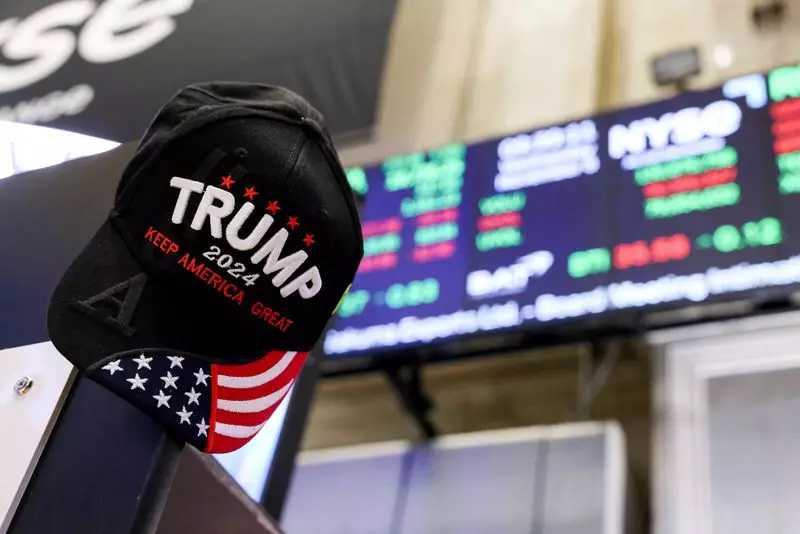Wall Street’s major indices experienced a downturn on Friday, illustrating that investor sentiment remains cautious amidst a blend of conflicting economic data and earnings results. This development was marked by a significant retreat in the technology sector, particularly with major players like Nvidia leading a reversal from earlier-week highs. As traders prepared for a week characterized by critical economic announcements and a Federal Reserve meeting, the overall sentiment appeared tepid.
The housing market data, which outpaced expectations, contrasted sharply with a concerning survey from S&P Global showing a decline in business activity, sinking to a nine-month low. Compounding the situation, price increases suggested inflationary pressures might still be present, prompting concerns over economic stability. Nevertheless, the job market showcased some resilience, as firms reported an uptick in hiring, reinforcing the Federal Reserve’s cautious stance on monetary policy moving forward.
The University of Michigan’s final take on consumer sentiment also fell, declining to 71.1, a drop from the previously reported 73.2. This further contributed to the cautious atmosphere as investors absorbed a relatively light week of data, with most anticipating the Fed would maintain steady interest rates during their meetings scheduled for January 28-29, while eyeing potential rate cuts in the upcoming months.
Scott Helfstein, the head of investment strategy at Global X, succinctly captured the prevailing mood: “It really boils down to some mixed economics and earnings news.” The market appears to be bracing itself for an upcoming barrage of critical inflation indicators and economic growth metrics, alongside the Fed’s upcoming policy decisions. The uncertainty concerning the new administration’s policies only adds to this apprehension as stakeholders digest the implications of projected tariffs introduced by President Trump.
The potential for additional tariffs, set to target nations including Mexico and China, has led many to speculate about the ramifications for inflation and Fed actions regarding interest rates. Trump’s recent references to the formulation of trade policies without providing explicit details have only exacerbated investor skepticism regarding future economic directions.
In terms of performance, the Dow Jones Industrial Average closed down 140.82 points, or 0.32%, reaching 44,424.25. The S&P 500 followed suit, losing 17.47 points (0.29%) to settle at 6,101.24, while the Nasdaq Composite dipped 99.38 points, or 0.50%, landing at 19,954.30. Despite the daily declines, there was some positive news as the indexes had managed to secure gains over the previous week, with the S&P 500 ticking up by 1.74% and the Nasdaq by 1.65%.
Interestingly, while six of the eleven S&P 500 sectors saw upward movement, the tech industry, typically a market leader, lagged significantly. This was exemplified by a disastrous 7.2% drop in shares of Texas Instruments, which revised down its profit forecast amid rising inventory concerns. Nvidia, a paragon of the semiconductor industry, suffered a 3.1% loss, highlighting a concerning trend amidst technological market volatility. Other tech giants such as Microsoft and Tesla also saw declines, reinforcing this sector’s struggles on the day.
Apart from technology, the services industry saw favorable developments, particularly for companies like American Express that reported a 12% increase in fourth-quarter profits, despite a decline in share price post-announcement. Boeing added to the day’s woes after hinting at potential losses, projecting a fourth-quarter shortfall of approximately $4 billion.
Market Breadth and Investor Behavior
Investor breadth indicated a mixed performance from market participants, as advancing issues outperformed decliners on the New York Stock Exchange with a ratio of 1.45 to 1. This was reflected in the emergence of 249 new highs against 32 new lows. The Nasdaq reflected a similar trend, with 2,242 stocks experiencing gains versus 2,140 that fell, yielding a ratio of 1.05. Notably, both indices recorded numerous new 52-week highs, signaling a complex landscape of investor sentiment and market health.
As trading volumes remained relatively robust with 14.02 billion shares exchanged—slightly below the 20-session average—it becomes clear that despite a turbulent day, underlying currents of optimism still persist among certain sectors. Investors’ palpitation regarding upcoming policy updates and economic indicators signals a landscape ripe for volatility, leaving both opportunities and pitfalls in the wake of recent developments.

